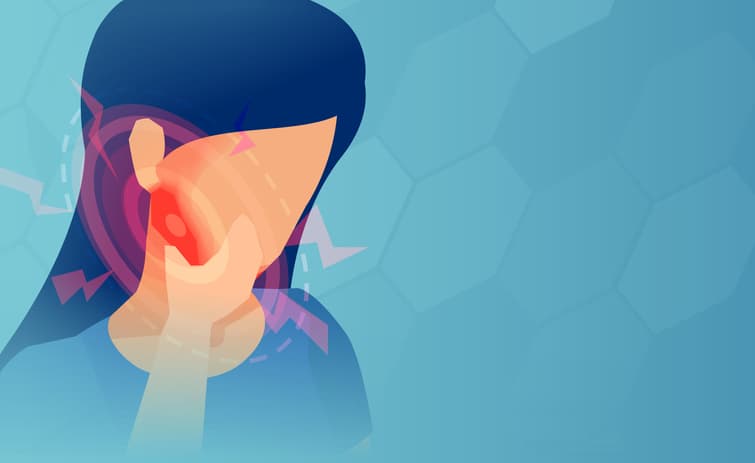
Because TMJ anatomy is complex, there are many ways to end up with disorders and painful issues. We will share what makes up this joint and the disorders linked to it known as temporomandibular disorders, or TMD when there are problems with the muscles and joints in your face.
What Are the Parts of the TMJ?
This part gets a little technical, but it is vital to understand all of the moving parts when you are dealing with an issue. Your lower jaw, also known as the mandible, has two vertical extensions from each side, with a condyle at the top. The condyle can be many shapes and asymmetrical, but it creates the configuration that allows for articulation. The TMJ is where the condyles meet the temporal bone of the skull.
There is a disc, similar to the ones you have in your back, that fills the space between these two bones, keeping them from rubbing together. There are membranes, fluids, blood vessels, nerves, as well as connective tissue, in the area behind the articular disc. Three ligaments help stabilize the joint, prevent the dislocation of your jaw and support the weight of the mandibular bone.
How Does This TMJ Anatomy Function?
The TMJ is different from other joints of your body in that it permits both sliding and hinging action. With most joints in our bodies, we want them to allow movement in one direction, we don’t want them to slide back and forth, but this one will enable you not just to open and close your mouth, but also to push your jaw forward, bring your jaw back and even move it from side to side. While the joint is where this motion takes place, there are muscles of mastication that are the ones that produce the movements.
- Masseter–This is the most powerful of the four muscles of mastication (chewing). It has two parts and is responsible for lifting your mandible and closing your mouth.
- Temporalis–Besides lifting the mandible and closing your mouth, this muscle also retracts the jawbone, which pulls it back into place.
- Medial pterygoid–Just like the masseter and temporalis muscles, it is part of the process that elevates your mandible and closes your mouth.
- Lateral pterygoid–This muscle is mainly responsible for sliding your jaw forward, but it also moves the jaw from side to side.
These four muscles receive a signal to act by the mandibular nerve, which branches off of the trigeminal nerve located in the brain. Like all parts of your anatomy, the brain understands you want to open or close your mouth and signals these muscles to work together, making the movements necessary for this to happen. And like all parts of the body, sometimes things can get agitated or injured and the muscles and joints don’t function properly.
What are TMJ Disorders?
The TMJ is complex, and obviously, we use it extensively in our daily lives. While it is not uncommon, it can be uncomfortable and even painful. The elements that comprise the articular disc is different in women, which makes this condition more prevalent in women.
While the source of a problem may not always be evident, discomfort can be caused by injury, trauma to the jaw, long-term grinding, muscle spasms from stress, misaligned teeth or some form of arthritis. Some TMJ problems can resolve themselves with little to no treatment. Still, you should always see your dentist if you notice any of the symptoms of TMD.
What Are the Signs & Symptoms of TMD?
It can be hard to determine if it is what you are experiencing is TMD because one or all of these symptoms can also occur when dealing with other issues. Your dentist can help make a proper diagnosis.
Some of the most common TMD symptoms include:
- Pain in the face, jaw or ear area
- Headaches (sometimes severe), earaches, and pain and pressure behind the eyes
- A clicking sound or popping sensation when opening or closing the mouth
- If your jaw gets stuck, locked or goes out of place
- Tenderness of the jaw muscles
- Swelling of the face
Can I Alleviate TMD Symptoms?
Because of the complexity of the jaw and the variety of symptoms and issues, there is no one cure. There are, however, different treatments that may reduce your symptoms dramatically. Your dentist may recommend one or more of the following:
- Medication – There are both over the counter and prescription medications to eliminate muscle spasm and pain, such as muscle relaxants, aspirin, or anti-inflammatory drugs.
- Wear a nightguard – If your dentist determines that your pain is due to clenching or grinding your teeth while you sleep, you can reduce the harmful effects by wearing a nightguard or splint.
- Relax – This is, of course, easier said than done, but you can start by learning relaxation techniques to help control muscle tension in the jaw. Your dentist may suggest you seek training or counselling to help eliminate stress.
- Physical Therapy – There are exercises that you can do to stretch and strengthen jaw muscles. Other treatments available are ultrasound, moist heat and ice.
- Surgery – If other methods have not proved effective, your physician or dentist may recommend surgery.
How Do I Maintain a Healthy TMJ?
As with any oral health issue, a good oral hygiene routine that includes brushing twice a day with toothpaste, such as and flossing daily is key to your oral health. By scheduling your routine exams, your dentist can check your teeth and TMJ for signs of trouble.
The complexity of TMJ anatomy can be daunting. But, when you are familiar with the basics of how your temporomandibular joint works, it may help you better understand what you can do to help keep it in good working order for many years to come.
